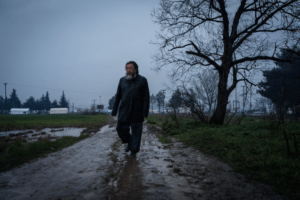Techno-Art of the Moment, Featuring Laura Poitras, Ai Weiwei and the Mona Lisa
“Seven on Seven: Empathy and Disgust,” a New York event, couples artists with technologists or activists and gives them 24 hours to produce something. And those “somethings” turn out to be most interesting. That would be paint, not pixels: the eyes of Leonardo da Vinci's Mona Lisa. (Wikimedia Commons)
That would be paint, not pixels: the eyes of Leonardo da Vinci's Mona Lisa. (Wikimedia Commons)
The one thing perhaps stranger than how humans watch each other through computers is how computers perceive reality. According to one computer, for instance, the Mona Lisa is “a pretty young blonde in a black dress taking a selfie.”
The interface between human and computer was just one of the subjects on view last weekend at Rhizome’s “Seven on Seven: Empathy and Disgust,” a conference at the New Museum in New York City.
Seven artists were paired with seven technologists, and the six pairs who were in New York were given 24 hours to produce anything they could come up with.
The Mona Lisa interpretation was composed by artist Trevor Paglen, Instagram co-founder Mike Krieger and a special guest, privacy artist and designer Adam Harvey. The trio experimented with computer vision and interpretation. Their computer thought Burt Reynolds’ famous nude Cosmopolitan centerfold was a “drumstick” and Nick Ut’s iconic Vietnam War photo was “people walking on a beach.”
The misunderstandings were verbal as well as visual: Berlin-based artist Hannah Black and the language hacker thricedotted explored whether a computer could understand language that was dictated to it. The results were mixed. Black observed that maybe “robots cannot read us because we cannot read ourselves yet.” A question from the audience: “Are we being unfair to bots by making them speak English?”
Notably, filmmaker Laura Poitras debuted a rough cut of her first film since “Citizenfour,” her documentary about Edward Snowden. The new film, “Surveillance Machine,” tracked the shipment of dozens of panda plushies that were smuggled into the United States from China. The pandas were stuffed not with cotton but with shredded surveillance documents released by Snowden.
Ai Weiwei, the Chinese artist-activist, collaborated on “Panda to Panda” with digital security expert and activist Jacob Appelbaum. Ai has been unable to travel since the Chinese government revoked his passport. U.S. citizen Appelbaum lives abroad, an exile widely attributed to his association with WikiLeaks, which remains under U.S. criminal investigation.
The film opened with Appelbaum casually handing Ai surveillance documents to feed into a paper shredder. “I thought only the Chinese have this,” an astonished Ai said, looking at one U.K. surveillance document.
Smuggling pandas filled with shredded documents was a powerful display of the irony behind Western criticism of Chinese censorship. Snowden revealed that many of the surveillance techniques employed by China are also practiced in the West.
Being watched coerces us to self-censor and eventually change our patterns and thoughts. This is the premise behind the Panopticon, the “total surveillance prison” envisioned by English philosopher Jeremy Bentham. Perhaps the replacement of the insides of the toy pandas represents the internalization of censorship; the shredding of documents and subversion of a cultural icon, a form of resistance.
The exhibit featured back-to-back presentations by the collaborators, many of whom slept little if at all during their 24 hours of activity (Ai and Appelbaum had 48 hours). A recurring theme was how machines translate—and often mistranslate—human experience.
Harlo Holmes, who develops secure apps for human rights defenders, and French artist-sculptor Camille Henrot explored the extent to which our computer desktops are a reflection of self. They created a tool that analyzes a computer desktop as a response to a question, on the premise that desktops are dream-like; they contain ideas yet to be processed.Los Angeles-based artist Martine Syms and Lifehacker founder Gina Trapani offered a fresh take on personality testing with a quiz that involved security questions that websites ask you when you forget a password. Their premise was that aggregated security questions offer an intimate self-portrait and reveal how readily we divulge details of ourselves to websites.
British artist Liam Gillick and FiveThirtyEight statistician Nate Silver developed a livestream from 4.5 million failed U.S. trademark ideas. It was their way of guaranteeing risk and uncertainty: “It’s hard to find datasets that show failure,” observed Silver. Some of the failed ideas included “Compost you’ll dig,” “I pity the tool,” “April is the new March,” “Men who change diapers change the world” and “Rent the chicken.”
Finally, Los Angeles-based video artist Stanya Kahn and Vine co-founder Rus Yusupov documented a creative process using six-second “vines.” They notably had divergent ideologies: Yusupov said “the future of art is bliss,” to which Khan responded, “I don’t know what you’re talking about.” On a playful note, they contemplated leaking Appelbaum and Ai’s collaboration as their project.
My only reservation was whether “Seven on Seven” represented a movement accessible to ordinary people. The event (at which seats costs more than $100) was livestreamed, so anyone could watch at home. But, for me, concern came when at various points the collaborators were dubbed the “dissident elite.” That phrase is problematic. It would not seem to capture the artists’ visions. The point of encryption and other countersurveillance tools is to empower every citizen. All individuals have an ability to resist, no matter one’s status or privilege.
Technology itself is a form of human expression; “Seven on Seven’s” exploration revealed that its limitations are as much a commentary on machines as they are a reflection of ourselves.
Black pointed out that her team’s chatbot had responded to a question with a colonial slur. One observer on Twitter said that thricedotted, the bot’s developer, had the “look of a disappointed mother.”
Full synopses and updates will be available within a week at Rhizome.
Your support matters…Independent journalism is under threat and overshadowed by heavily funded mainstream media.
You can help level the playing field. Become a member.
Your tax-deductible contribution keeps us digging beneath the headlines to give you thought-provoking, investigative reporting and analysis that unearths what's really happening- without compromise.
Give today to support our courageous, independent journalists.






You need to be a supporter to comment.
There are currently no responses to this article.
Be the first to respond.